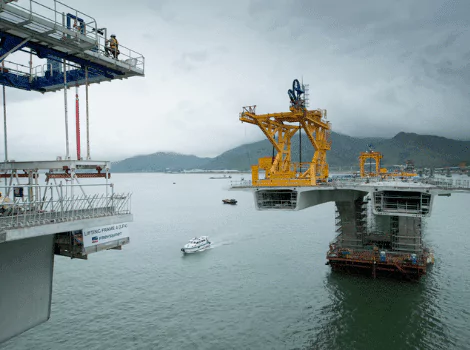Our portfolio of methods
1/ In situ construction
- Incremental launching
- Cast-in-place cantilever
- Construction on scaffolding
2/ Precast segmental erection
- Balanced cantilever erection with launching gantry / lifting frames / cranes
- Span by span erection with launching gantry / on falsework
- Precast girder erection
- Full span precast method
3/ Heavy lifting and handling of structures
- Heavy lifting: strand lifting, precision jacking
- Sliding techniques: autoripage, autofonçage, airpad sliding, lateral sliding
- Rotation systems
- Special formwork
-
1946First development and use by Freyssinet of industrialized methods for bridge erection, for the Luzancy bridge
-
320+Number of cable-stayed bridges where Freyssinet has been involved
-
70+Number of bridges built in situ by Freyssinet
-
50+Number of precast bridge decks erected by Freyssinet
Why choose Freyssinet

Hundreds of bridge and deck construction projects around the world for over 70 years, small to large-scale.
Applicable to:
- In situ construction
- Precast segmental erection
- Lifting and handling of structures
Including:
- Choice of construction method
- Optimization of superstructure design and construction method
- Design & supply of equipment and temporary structures
- Erection of the superstructure, equipment operation, concrete casting, prestressing
- Finishing work, including installation of structural fittings
- Maintenance and repair services
Proven ability to propose and implement alternative designs and methods to achieve the best possible value at the lowest life cycle cost.
Under the leadership of our Major Project Department for the largest and most complex projects, our specialist supervising teams are able to manage safely the construction project within budget and on time, taking into account all technical and environmental factors.
A global approach to bridge construction
Selection of construction method
- Structural design of substructure and superstructure
- Material quantities and specifications
- Review of options for the construction methodology
- Assessment of temporary works and special equipment requirements
- Phasing of works
- Cost estimates for budgeting
- First approaches to project, quality and safety management
Optimization of construction method & equipment
- Construction engineering
- Assistance to designers in reviewing all details that will facilitate construction
- Development of temporary works and special equipment
- Detailed methods of construction
- Integrated shop drawings for the fabrication of the superstructure
- Integration of post-tensioning with all associated drawings and details
- Design of temporary works associated with precast yards and molds
Execution
As a main contractor, subcontractor or through innovative partnership agreements, our teams are able to execute construction project efficiently, in compliance with specifications, costs, deadlines and quality:
- Mobilisation of an experienced project team
- Supply and operation of the temporary works for the precast yard and the superstructure construction
- Project and risk management and effective coordination with the various stakeholders
Monitoring and maintenance
Our teams can assist in monitoring the structure, advise on maintenance activities and help anticipate repair interventions and costs:
- Define the most suitable monitoring scheme, assess its cost
- Supply monitoring hardware and software
- Provide training and handover
- Inspect the structure and issue recommendations
- Propose and implement repair or strengthening plans if required
Our references
In situ construction methods
Learn morePrecast segmental erection methods
Learn moreIn situ construction methods
Learn morePrecast segmental erection methods
Learn moreContact us
You have a question about our solutions or you already have a project in mind? Please fill out the form below and our teams will get back to you shortly.
